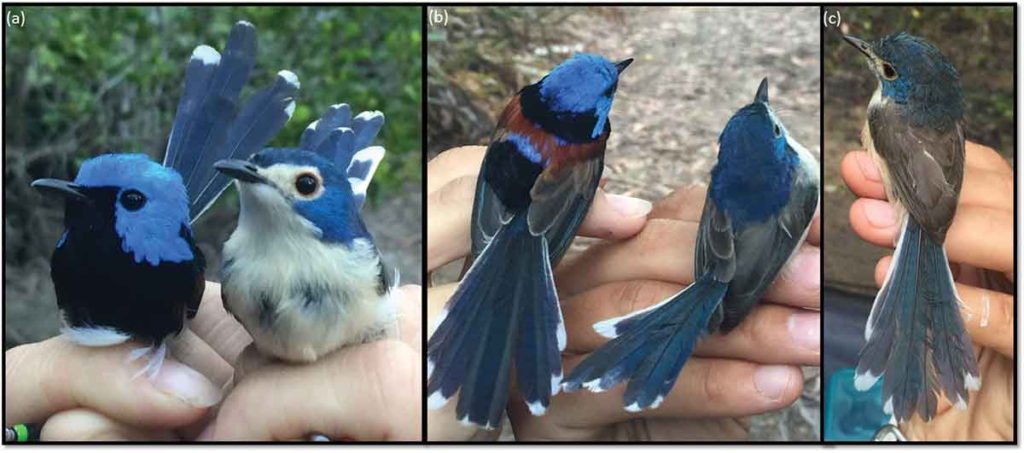The ecology and breeding biology of the Lovely Fairywren has been described for the first time! Friend of the Fairywren Project, Ana Leitão, has been researching these fascinating birds for a number of years and her first publication has just arrived.
One of the most interesting findings to us at the Fairywren Project is that Lovely Fairywren males maintain their bright breeding plumage year-round! This trait separates them from the rest of the Australian fairywrens where most males molt into a dull non-breeding plumage at the end of the breeding season and a bright breeding plumage prior to the beginning of the next breeding season. Males of some of these species are known to molt from bright plumage to bright plumage, but it’s rare for the entire population (or species!) to exhibit this. The fact that the Lovely Fairywren molts from bright plumage to bright plumage reminds us more of the White-shouldered Fairywrens in New Guinea which are also known to exhibit this trait.

Figure 1. (a) Male and female Lovely Fairy-Wren (Malurus amabilis) colour differences, frontal view and (b) dorsal view. (c) Dependent juvenile with duller version of the female plumage. Photos by Ana Leitão.
You can read and download the paper for yourself from the Emu – Austral Ornithology and find the paper summary below:
The Lovely Fairy-Wren (Malurus amabilis) is endemic to the wet tropics of Australia and is one of 11 species in the genus Malurus. Despite the large number of studies on fairy-wrens, little is known about the Lovely Fairy-Wren. This study provides the first detailed description of its ecology, behaviour, and breeding biology. Lovely Fairy-Wrens displayed breeding behaviour characteristic of tropical birds, with groups maintaining territories and breeding year-round, small clutch size (two to three eggs), long juvenile dependence (2 months) and high adult breeder survival (86%). They breed cooperatively, and groups formed when male (but not female) offspring delayed dispersal and remained in their natal group as subordinates. Groups were typically small (2.5 ± 0.8 individuals), possibly because productivity was low: 29% of the monitored groups produced at least one fledgling per year. Males provided high levels of parental care and this, together with low extra-pair courtship and petal displays, suggests that this species may not be as promiscuous as other fairy-wrens. Unlike other Australian fairy-wrens, males maintained their brightly coloured adult plumage year-round after initial acquisition. This lack of seasonal moult into dull plumage, coupled with the unusually colourful plumage of females in this species, suggests that the impact of natural selection on the plumage colour of both sexes may be lower in this species than in their congeners. We discuss similarities and differences in life-history and morphological traits between the Lovely Fairy-Wren and other Malurus species.
